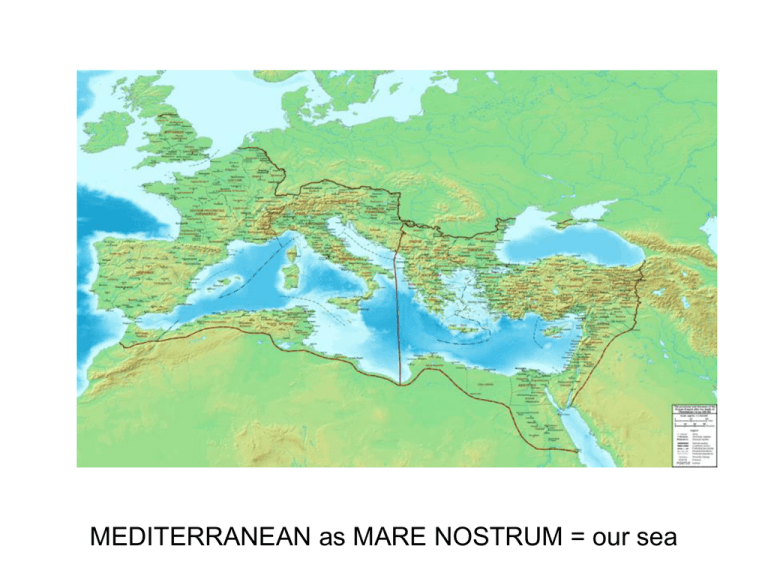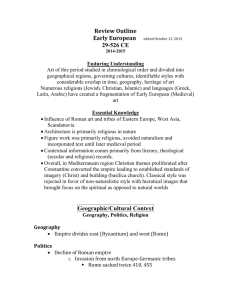Constantine to Sack of Rome in 410 AD
advertisement

MEDITERRANEAN as MARE NOSTRUM = our sea DECLINE OF ROME: "Second" Empire from 3rd C. military pressures: in East, Persian Sassanid Empire 260 Emperor Valerian dies in captivity in NW, Germanic tribes (Goths, Franks, Alemanni) tribes elect chiefs (kings, koenig) 250 AD first raids Symbol & response building of Aurelian wall around Rome, 271 AD Result: military revolution, Germanization of army, increase in taxation to support army 271 Aurelian wall in red Servian wall in black Military revolution of 3rd Century begins with temporary measures under Marcus Aurelius: resorts to conscription of slaves, gladiators, criminals, barbarians (Germans) Septimus Severus 193-211 opens Praetorian Guard to Germans increasing militarization, rise in taxes rise of provincials and Germans in army: Diocletian: son of freedman from Dalmatia social revolution in army and ruling class Diocletian 284-305 TETRARCHY 284-305 AD “rule of four” DIOCLETIAN’S REORGANIZATION OF EMPIRE: Motive: military defense of frontiers orderly succession Four rulers: two Augusti (Diocletian as Senior Augustus) they choose two Caesars (adopted successors, not their own sons) Four Prefectures and four capitals: none at Rome WHERE IS ROME? Four Prefectures and their capitals: GAUL Capitals: Trier ITALY | Milan ILLYRICUM | Sirmium (near Belgrade) ASIA | Nicomedia (on Bosphorus Straits near Byzantium) Imperial government under Diocletian: 4 prefectures, each divided into 12 dioceses, which are then divided into 100 provinces for local government and tax collection Western Empire: capitols – Trier and Milan Eastern Empire: capitols – Sirmium and Nicomedia • Four Prefectures and their capitals: (none at Rome) • GAUL ITALY ILLYRICUM ASIA • Capitals: • Trier | Milan | | Sirmium Nicomedia (near Belgrade) (on Bosphorus near Byzantium) • Rulers: West East Senior Caesar Augustus Augustus Caesar Constantius Maximian Diocletian Maximianus | | (abdicate in 305 AD) Son Son | | Constantine Maxentius PALACE OF DIOCLETIAN, SPLIT (modern Croatia) Split (in modern Croatia) site of Diocletian’s palace BATHS OF DIOCLETIAN, ROME Basilica of San Marco Venice 11-12th C. Rulers: Caesar | West | East | Augustus Senior Augustus | | Constantius Maximian Diocletian | | (abdicate in 305 AD) son son | | Constantine Maxentius Caesar | Maximianus • 305 Abdication of Diocletian and Maximian their Caesars become Augusti New Caesars chosen: Italy: Flavius Valerius Severus (under Constantius) Illyricum: Galerius Valerius Maximinus Daia (under Maximianus) • 306 - 312 battle for succesion among all of the above, except Diocletian, including sons of western Augustus (Maxentius) and western Ceasar (Constantine) plus addition of Licinus in 308; 312 Constantine invades Italy: defeats & kills Maxentius at Battle of Milvian Bridge: vision of cross in Sun voice: “In this Sign you will conquer.” 313 Edict of Milan: toleration of Christianity in Empire 313 Licinius consolidates military hold on East 323 Battle of Adrianople: defeat of Licinius by Constantine 324 Constantine sole Emperor in East & West CONSTANTINE SERIES, RUBENS 17TH C. CONSTANTINE VERSUS MAXENTIUS Constantinople as "new Rome" and "capital of Christianity": 330 capital moved to Byzantium/Constantinople – religious, military & administrative reasons remains capital until 1453 (Ottoman Turks) 390 Christianity becomes official religion of Empire under Emperor Theodosius I (378-395) pagan sacrifices outlawed, including in city of Rome BASILICA OF MAXENTIUS & CONSTANTINE in Roman Forum | CHRISTIANITY IN ROME Christ as Jewish prophet: born under reign of Augustus crucified under Tiberius 33 AD Early Christian martyrs (those who died for the faith) St. Peter: first of the Apostles “Thou art Peter and upon this Rock I will build my Church.” Gospel of St. Matthew St. Paul: Jewish, Roman citizen Apostle to the Gentiles (= non-Jewish people) converted on road to Damascus author of Epistles (Letters) to Romans, Corinthians 15th C. Crucifixion of St. Peter Lippi 17th C Caravaggio Crucifixion of St. Peter Characteristics of Christian religion: 1) cosmopolitan, universalist (= catholic in Greek) anyone can join 2) scripture (writings) as basis of Christian identity: Gospels: Matthew, Mark, Luke, John Epistles (letters): especially those of Paul 3) egalitarian: ignore distinctions of “slave” vs “free” 4) communal: social support for poor, widows rituals define who belongs: Baptism, Communion 260-302 period of toleration of Christians 303-305 persecutions of Diocletian 325 COUNCIL OF NICEA: 1st ecumenical (world-wide) council of Christian Church called by Constantine acting as head of church CAESAROPAPISM: Caesar acts as Pope, fusion of Church and State council condemns as heresy (incorrect doctrine) the view of the Trinity taught by ARIANS: followers of Arius hold that Christ as son is lesser being than Father Nicene Creed : orthodox definition of Trinity stated by Council of Nicea Son is of “same substance” with the Father (Greek = homo-ousia) Basilica of St. Peters built on site of Nero’s Circus 4th Century migrations from central Asia (through 10th C.) nomadic horsemen from Asian steppes first = Huns Bulgars, Mongols last = Magyars (9-10th C) pressure on German tribal confederations allied with Rome Map of Rome with Aurelian Walls and Christian Churches Christian Churches built on peripheries St. Peters San Paulo fuori le mure San Lorenzo fuori le mure San Giovanni in Laterano MEDITERRANEAN as MARE NOSTRUM = our sea Roman influence on Germans: military tactics, service in Roman army political organization: from 4th C. first tribal confederations Alemanni = “all men” Franks = “free men” 5th C. INVASIONS: Visigoths, Alaric, Vandals, Huns 410 AD SACK OF ROME BY ALARIC / VISIGOTHS DOCTRINE OF PAPAL PRIMACY IN ROME East: CAESAROPAPISM -- "Caesar acts as Pope" pattern set by Constantine; Church as department of state Emperor calls church councils, decides doctrinal disputes West: Roman church resists Imperial control from the East evolve doctrine of papal primacy within Church Pope as primus inter pares (first among equals among Christian Bishops) tension between church and state APOSTOLIC SUCCESSION from Peter gatekeeper of Heaven, holds "keys of kingdom" Scriptural foundation of Peter's authority: Matthew 16:18 "Thou art Peter & upon this rock I will build my church.“ body in Vatican: relic, pilgrimage site; pallium (symbol of Papal authority) placed on tomb of St. Peter by each newly chosen pope CHRISTIANITY IN THE ROMAN EMPIRE: Constantine as first Christian Emperor 313 Edict of Milan: toleration of Christian worship 324 Capital moved to Constantinople: Christian city, free of Roman paganism 337 deathbed Baptism of Constantine Theodosius the Great 390 suppression of pagan worship including the city of Rome St. AUGUSTINE AND CHRISTIAN WORLD VIEW theologian, Bishop of Hippo (north Africa); Church Father Autobiography = Confessions: mother Monica; Carthage; conversion; Bishop Ambrose of Milan Refutation of 4-5th C. Heresies (incorrect doctrines): Manicheanism: problem of evil in monotheism dualism as explanation for evil: good God vs evil God omnipotence of God vs goodness of God; Augustine: theory of evil as absence of good Pelagianism: 4th C. Roman priest, Pelagius salvation through effort, good works = morality Augustine: original sin as totally corrupting, need grace FIFTH CENTURY INVASIONS pressure on German tribes from Asiatic peoples moving west VISIGOTHS (West Goths) Arians ULFILAS 4th C: translates Arian Bible to Gothic 370 AD request permission to missionary enter Empire 376 disarmed Goths attacked by Roman army; war 378 Battle of Adrianople: defeat of EMPEROR VALENS by Goths new EMPEROR THEODOSIUS (378-395) makes temporary peace with Goths, aided by STILICHO THE VANDAL: minister under Theodosius able to deal effectively with Visigoths 410 Sack of city of Rome by Alaric the Visigoth (German) pagans blame Christians for the sack of Rome declining role of Roman Senate since Diocletian St. Augustine’s response: Christian theory of history 413 CITY OF GOD (vs City of man): Christian versus Roman explanations of Sack of Rome : Roman: abandonment of worship of official Roman gods Augustine: Rome as the “city of man,” impermanent, state as punishment for original sin, fallen heavenly City of God versus earthly city (Rome) but Roman Empire divinely ordained to spread Christianity divine Providence guides history towards last days







